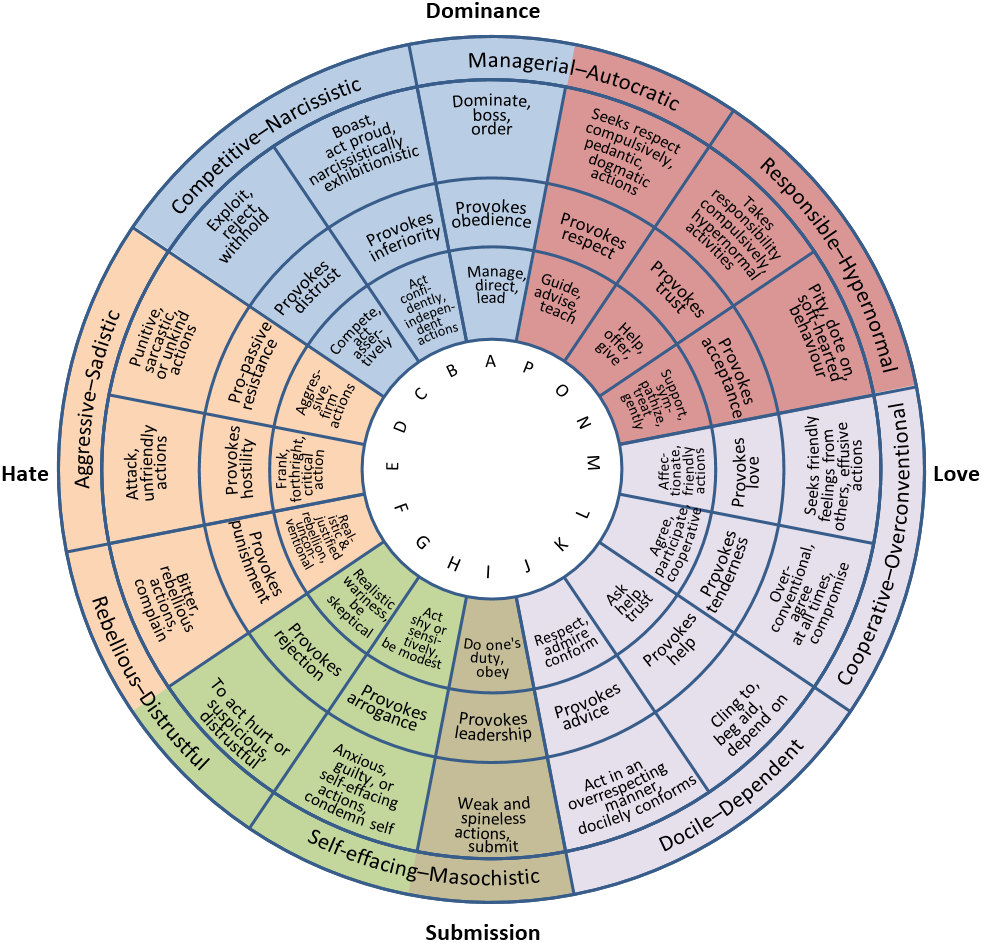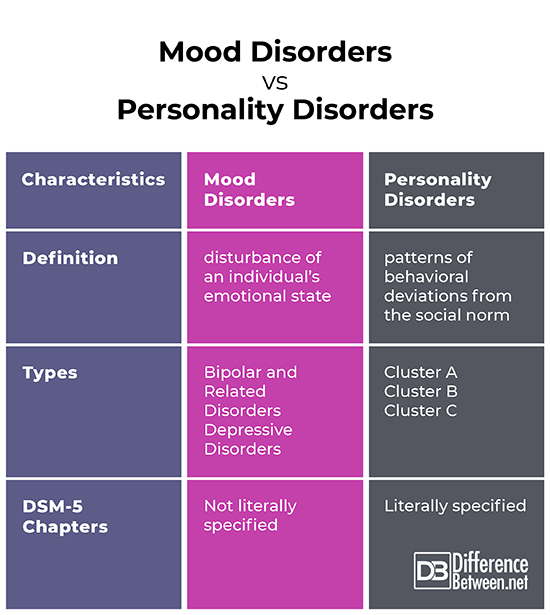Difference Between Mood Disorders and Personality Disorders
Mood disorders and personality disorders are both exemplified by the impairment of important areas of functioning. Specifically, mood disorders refer to a group of conditions characterized by a significant disturbance of an individual’s emotional state and its related functions. On the other hand, personality disorders refer to enduring patterns of deviations from the social norm. More distinctions are discussed in the following sections.

What are Mood Disorders?
Mood disorders or mood affective disorders are a group of conditions characterized by a significant disturbance of an individual’s emotional state and its related functions. The Diagnostic and Statistical Manual of Mental Disorders (DSM-5) separated mood disorders into bipolar and related disorders and depressive disorders (DiMaria, 2020).
The different kinds of bipolar and related disorders and depressive disorders and some of their main diagnostic criteria include the following (DSM-5, 2013):
Bipolar and Related Disorders
- Bipolar I Disorder
This is characterized by having at least a week of manic episode, a period of abnormally elevated or irritable mood, and increased energy. Its symptoms include decreased need for sleep, inflated self-esteem, flight of ideas, unrestrained shopping, and sexual indiscretions. The manic episode may be preceded by and may be followed by major depressive or hypomanic (abnormally elevated mood or irritability for four consecutive days) episodes.
- Bipolar II Disorder
This diagnosis requires the occurrence of a hypomanic episode and a major depressive episode which is characterized by a 2-week-period of depressed mood or loss of interest.
- Cyclothymic Disorder
Patients with this condition have experienced hypomanic and depressive symptoms; however, they do not meet the respective criteria for these disorders.
Depressive Disorders
- Disruptive Mood Dysregulation Disorder
This is characterized by severe recurrent verbal rages, physical aggression, and other forms of temper outbursts which occur on average for at least three times a week for a year or more.
- Major Depressive Disorder
Those with this condition may, for at least two weeks, feel sad, hopeless, empty, or worthless. They may also have weight loss or weight gain, insomnia or hypersomnia, psychomotor agitation or retardation, fatigue, diminished ability to concentrate, and/or recurrent thoughts of death.
- Persistent Depressive Disorder
This is characterized by clinical depression which lasts for at least two years.
- Premenstrual Dysphoric Disorder
Women with this condition may experience mood swings, marked irritability, marked anxiety, and depressive symptoms before menstruation.

What are Personality Disorders?
The DSM 5 classifies personality disorders into clusters A, B, and C. Cluster A constitutes odd or eccentric traits, cluster B is characterized by dramatic, erratic, or emotional traits, and cluster C is associated with being fearful or anxious. The following specify such disorders and some of their main criteria:
Cluster A
- Paranoid Personality Disorder
This is exemplified by persistently suspecting others without sufficient basis, bearing grudges, and being quick to react angrily to misperceived attacks.
- Schizoid Personality Disorder
Those with this diagnosis have a pervasive pattern of social detachment and restricted expression. The symptoms include lacking close friends, exhibiting emotional coldness, and rarely enjoying social activities.
- Schizotypal Personality Disorder
This is indicated by irrational beliefs that random occurrences are related to oneself, magical thinking, odd thinking, unusual speech and perceptual experiences, suspiciousness, inappropriate reactions, eccentric behavior, lack of close friends, and social anxiety.
Cluster B
- Antisocial Personality Disorder
This is exemplified by a pattern of failure to conform to norms, disregard for others’ rights, deceitfulness, impulsivity, lack of remorse, irresponsibility, and/or irritability.
- Borderline Personality Disorder
Those with this condition have unstable interpersonal relationships, identity, and emotions. They may have frantic efforts to avoid abandonment (may be merely imagined), suicidal behavior, feelings of emptiness, inappropriate anger, and paranoid ideations.
- Histrionic Personality Disorder
This is characterized by excessive emotionality and attention seeking behavior. The symptoms include always wanting to be the center of attention, provocative behavior, rapidly shifting emotions, impressionistic yet shallow speech, exaggerated behavior, and perceiving relationships to be more intimate than they actually are.
- Narcissistic Personality Disorder
Those with this condition have a pattern of grandiosity, lack of empathy, and need for excessive admiration. They often exaggerate their achievements, exploit others, have fantasies of power and ideal love, believe that they are highly special, envy others, and show arrogant behavior.
Cluster C
- Avoidant Personality Disorder
This is characterized by social inhibition, low self-esteem, and hypersensitivity to criticisms. Those with this condition may avoid interpersonal contact due to fear of rejection and generally view themselves as inadequate.
- Dependent Personality Disorder
This is a pervasive pattern of submissive and clingy behavior due to the excessive need to be cared for. The symptoms include being extremely indecisive, needs others to take responsibilities for them, significant difficulties in expressing disagreement, extremely uncomfortable when alone, and irrationally preoccupied with being left to take care of oneself.
- Obsessive-Compulsive Personality Disorder
Those with this condition are irrationally preoccupied with perfectionism, orderliness, control, details, and rules.
Difference between Mood Disorders and Personality Disorders
Definition
Mood disorders refer to a group of conditions characterized by a significant disturbance of an individual’s emotional state such as clinical depression and persistent manic episodes. On the other hand, personality disorders refer to enduring patterns of deviations from the social norm as evidenced by unhealthy and rigid patterns of behaving, thinking, and functioning; some of them include paranoid personality disorder, narcissistic personality disorder, and obsessive-compulsive personality disorder.
Types
DSM-5 separates mood disorders into bipolar and related disorders (e.g. bipolar I, bipolar II, and cyclothymic) and depressive disorders (e.g. disruptive mood dysregulation, major depressive, persistent depressive, and premenstrual dysphoric). In comparison, there are three clusters in personality disorders: A (eccentric traits), B (dramatic traits), and C (anxious traits).
DSM-5 Chapters
Unlike “Personality Disorders”, “Mood Disorders” is not specified as a chapter in DSM-5; instead, it features “Bipolar and Related Disorders” and “Depressive Disorders”.
Mood Disorders vs Personality Disorders

Summary
- Mood disorders refer to a group of conditions characterized by a significant disturbance of an individual’s emotional state while personality disorders refer to enduring patterns of deviations as exemplified by unhealthy and rigid patterns of behaving, thinking, and functioning.
- DSM-5 separates mood disorders into bipolar and related disorders and depressive disorders. In comparison, there are three clusters in personality disorders: A (eccentric traits), B (dramatic traits), and C (anxious traits).
- Unlike “Personality Disorders”, “Mood Disorders” is not specified as a chapter in DSM-5.
- Difference Between Hematoma and Melanoma - February 9, 2023
- Difference Between Bruising and Necrosis - February 8, 2023
- Difference Between Brain Hematoma and Brain Hemorrhage - February 8, 2023
Search DifferenceBetween.net :
Leave a Response
References :
[0]Burton, Neel. The 10 Personality Disorders. Psychology Today, 29, May 2012, 2012, https://www.psychologytoday.com/us/blog/hide-and-seek/201205/the-10-personality-disorders
[1]Burton, Neel. The 10 Personality Disorders. Psychology Today, 29, May 2012, 2012, https://www.psychologytoday.com/us/blog/hide-and-seek/201205/the-10-personality-disorders
[2]Diagnostic and Statistical Manual of Mental Disorders: Dsm-5. Arlington, VA: American Psychiatric Association, 2013. Print.
[3]DiMaria, Lauren. The Various Types of Mood Disorders. Verywell Mind, 23 March 2020, https://www.verywellmind.com/mood-disorder-1067175
[4]Image credit: https://commons.wikimedia.org/wiki/File:Reasons_for_Mood_Disorders_Illustration.png
[5]Image credit: https://commons.wikimedia.org/wiki/File:Leary%27s_Circle_and_Personality_Disorders.png
